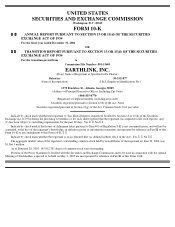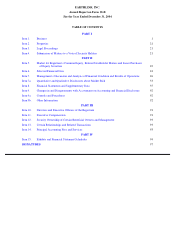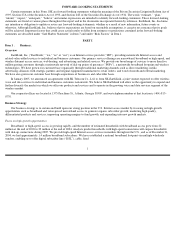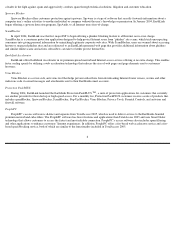Earthlink 2004 Annual Report Download - page 10
Download and view the complete annual report
Please find page 10 of the 2004 Earthlink annual report below. You can navigate through the pages in the report by either clicking on the pages listed below, or by using the keyword search tool below to find specific information within the annual report.
Network Infrastructure
We provide subscribers with Internet access through both EarthLink-managed facilities and third-party telecommunications service
providers. Approximately 95% and 92% of the U.S. population can access our premium-priced and value-priced access services, respectively,
through a local telephone call. We have developed, maintain and operate a network of approximately 9,500 access numbers and maintain
additional access numbers for backup and other purposes. We maintain a leased backbone connecting 18 cities and our three technology
centers. Our backbone is a networked loop of connections that we have acquired the right to use. Through a combination of backbone, peering
and transit, our network is capable of supporting more than five Gigabits per second of traffic at peak.
We have network service agreements with Level 3 Communications, Inc. (“Level 3”), MCI, Inc. (“MCI”), Qwest Corporation (“Qwest”)
and other carriers to provide dial-up services. We have agreements with BellSouth Corporation (“BellSouth”), Covad Communications
Group, Inc. (“Covad”), SBC Communications Inc. (“SBC”), Qwest, Verizon Communications Inc. (“Verizon”), and MCI that allow us to
provide DSL services. We also have agreements with Time Warner Cable, Bright House Networks and Comcast Corporation (“Comcast”) that
allow us to provide broadband services over each company’s cable network in all Time Warner Cable and Bright House Networks markets and
certain Comcast markets.
Regulatory Environment
Overview
The regulatory environment relating to our business and operations is evolving. A number of legislative and regulatory proposals under
consideration by federal, state and local governmental entities may lead to the repeal, modification or introduction of laws or regulations which
do or could affect our business. Significant areas of regulation for our business include telecommunications industry regulation in general,
broadband access and Internet taxation.
Telecommunications Regulation
Neither the Federal Communications Commission (“FCC”) nor any other governmental agency directly regulates ISPs, which are
classified as providers of unregulated “information services” rather than regulated “telecommunications services” under the terms of the
Telecommunications Act of 1996. Accordingly, most regulations which apply to telephone companies and other common carriers do not apply
to us. For example, we are not currently required to contribute a percentage of gross revenues from our Internet access services to universal
service funds used to support local telephone service and advanced telecommunications services for schools, libraries and rural health care
facilities. However, we are permitted to bill our customers to recover universal service fees passed through to us by our telecommunications
vendors. The classification of Internet access services as “information services” may discourage states from regulating ISPs as
telecommunications carriers or imposing similar subsidy obligations.
Nevertheless, Internet-
related regulatory policies are continuing to develop, and it is possible that we could be exposed to regulation in the
future. For example, the FCC could subject certain services offered by ISPs to regulation as telecommunications services. Among other things,
the FCC could decide to regulate voice services provided over the Internet, such as VoIP, as “telecommunications” or a “telecommunications
service” even though Internet access itself might not be regulated. Such a decision could result in us being subject to universal service fees,
access fees and other fees imposed on regulated telecommunications providers as well as heightened costs of regulatory compliance.
7























